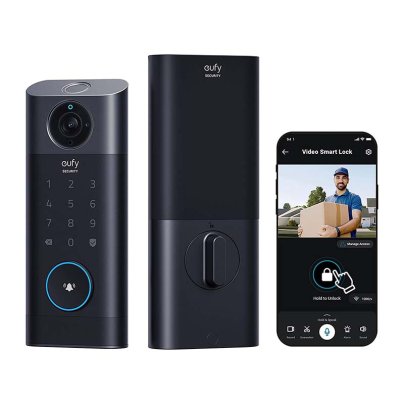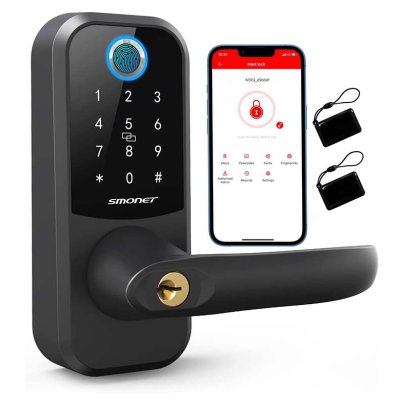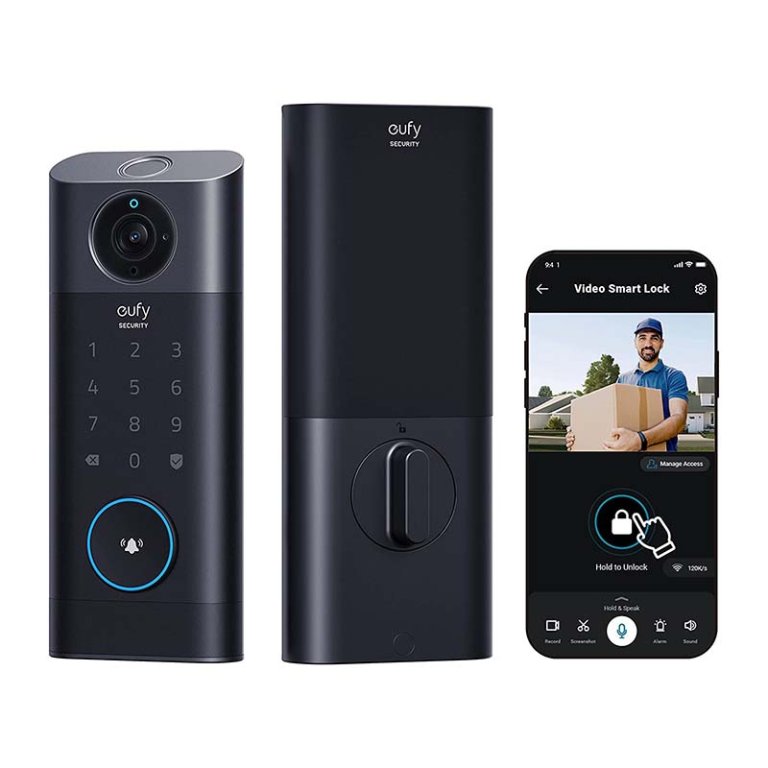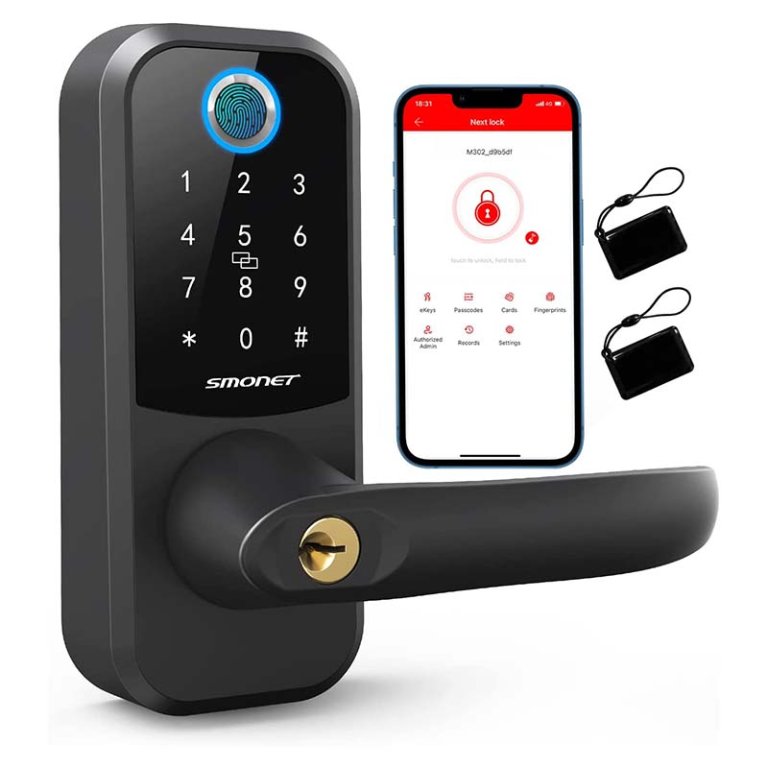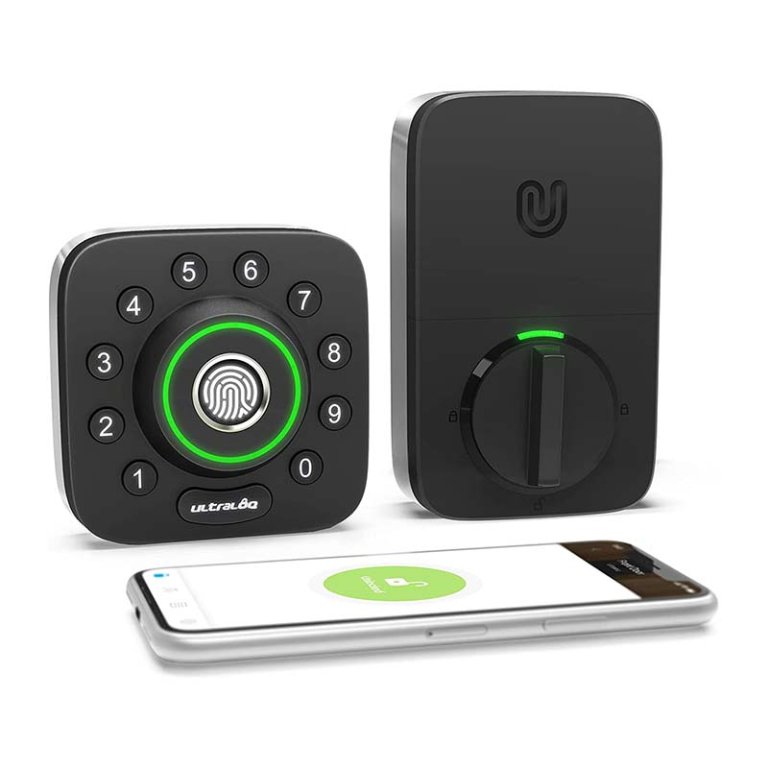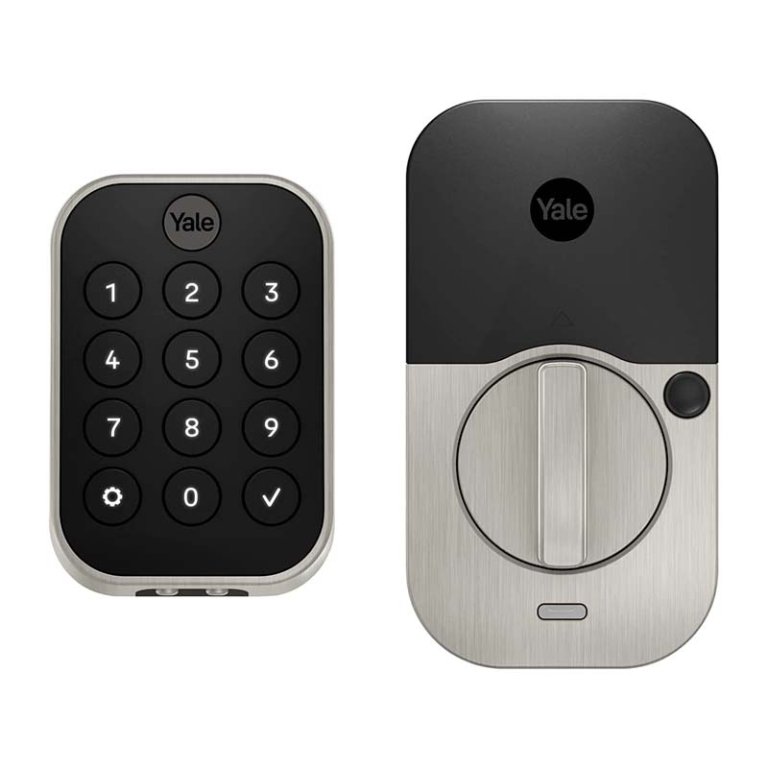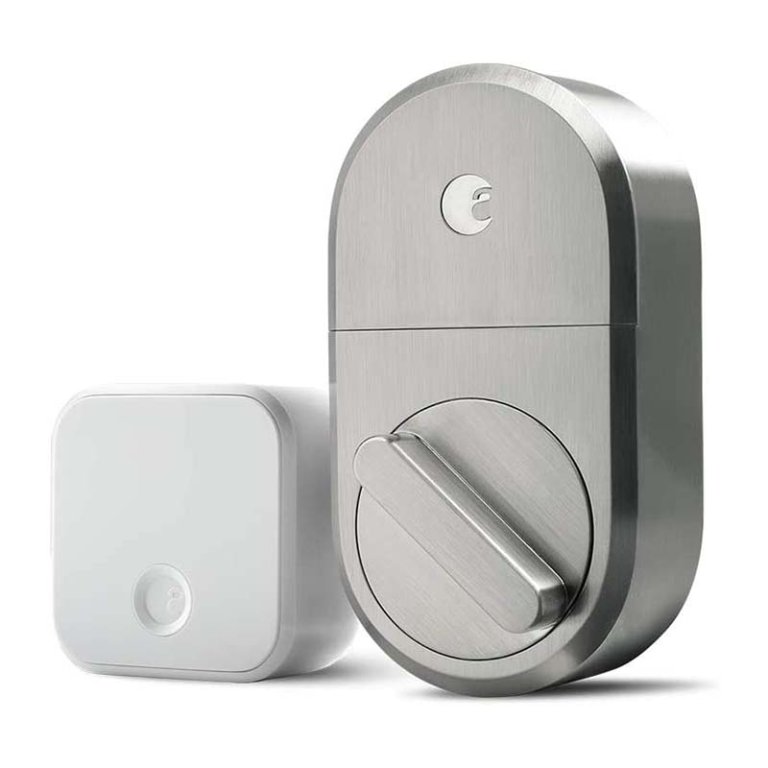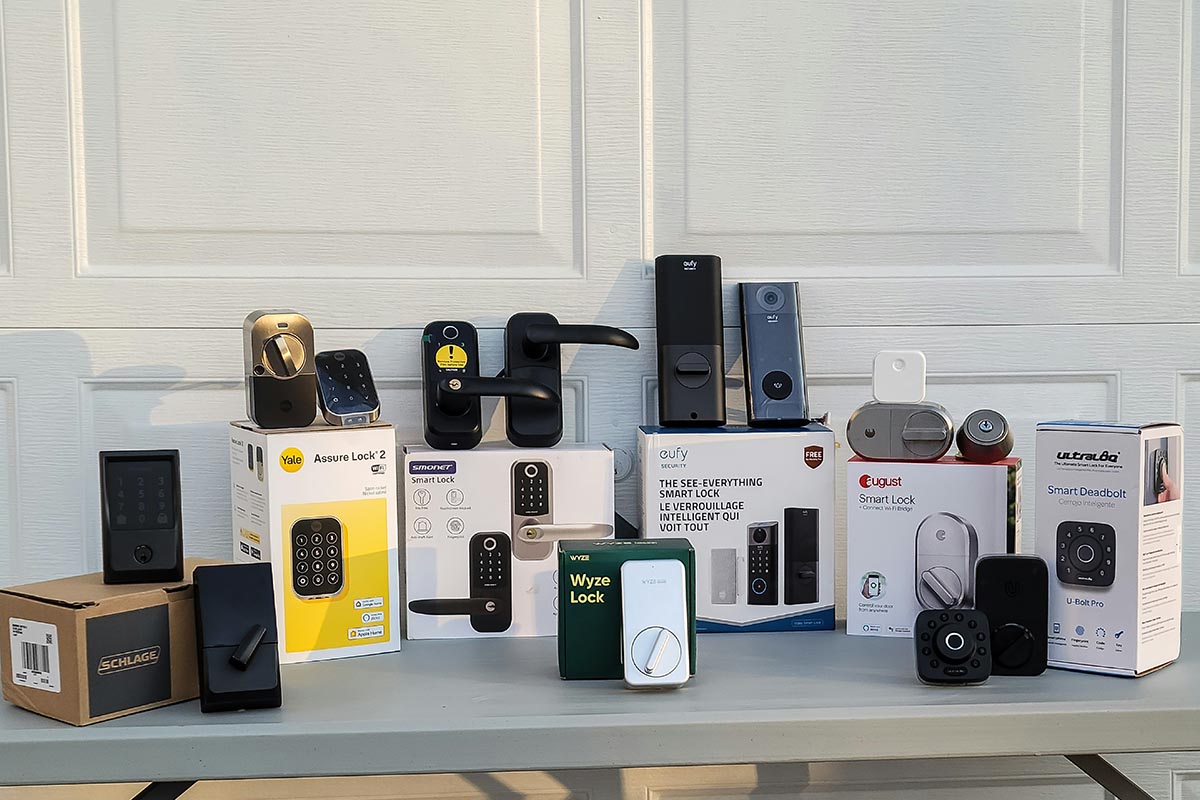
We may earn revenue from the products available on this page and participate in affiliate programs. Learn More ›
Say goodbye to keys and hello to extra home security with one of today’s smart locks. It’s been a decade or so since smart locks began to replace traditional pin-and-tumbler locks on private homes, and increasingly sophisticated features have become the norm.
With all the technological advances of the past few years, we wanted to know just how convenient and secure today’s top smart locks really were. That’s why we tested them! We installed them on doors, synced our smart devices with their apps, tried their features, and noted how well they compared against one another and against standard door locks.
Whether you want to install a lock that’s straightforward and secure, add a lock that offers access to multiple guests, or integrate a high-tech lock into your smart-home plan, you can find the right smart lock to suit your needs. The best smart locks are easy to use and have state-of-the-art features—the following models impressed us enough in our hands-on testing to earn a spot on this lineup.
- BEST OVERALL: Eufy Smart Lock Touch
- BEST BANG FOR THE BUCK: Wyze Smart Lock
- BEST WITH FOB: Smonet Smart Lock With Handle | ZNS-H001
- BEST FINGERPRINT READER: Ultraloq U-Bolt 6-in-1 Smart Deadbolt
- BEST WITH ALARM: Schlage Encode Smart Wi-Fi Deadbolt With Camelot Trim
- BEST AUTO LOCK: Yale Assure Lock 2 Key-Free Pushbutton Lock Bluetooth
- ALSO CONSIDER: August Smart Lock + Connect Wi-Fi Bridge
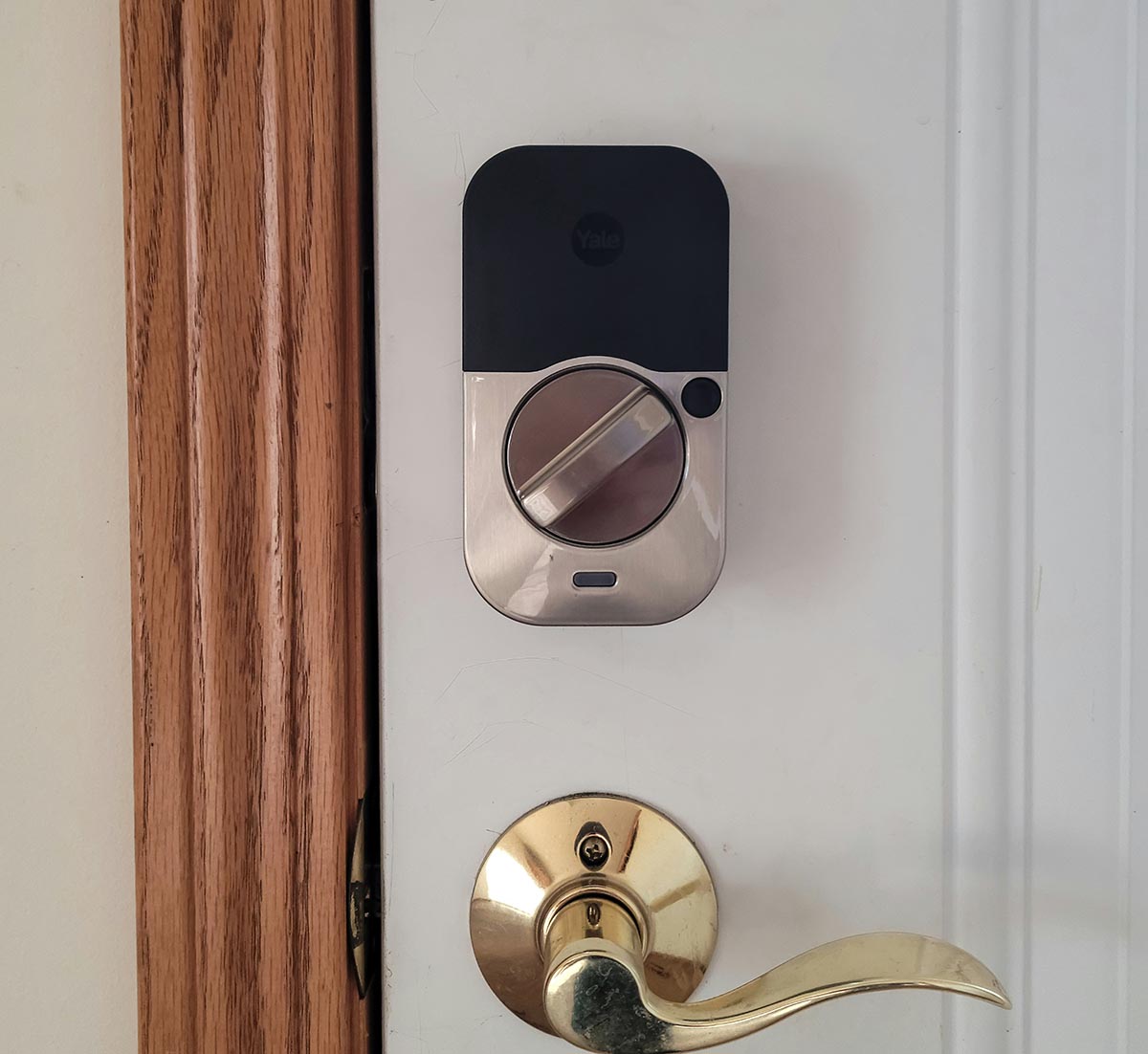
How We Tested the Best Smart Locks
We extensively researched more than 35 different models of smart locks before selecting the ones to try out in our hands-on testing. We looked carefully at the brand: Manufacturers such as Schlage and Yale have earned long-standing reputations for high-quality doorknobs and locks, while companies such as Eufy are considered tops in home security. Finally, we vetted locks by analyzing customer reviews and ratings and then narrowed our picks down to the top options in various categories.
To test the locks, we installed each one on an existing door. All replaced deadbolts or the interior portion of a deadbolt, except for one that replaced a locking doorknob. Installation was straightforward on all of the locks, primarily due to the vast majority of deadbolt locks and knobs being universal, meaning most install using the same method. In every case, only a Phillips screwdriver was necessary. They all needed batteries to operate the smart functions, and we installed them next.
We tested each lock by downloading and installing the apps and then using them to configure the lock’s features. We tried each feature, configured the locks, and synced them to Bluetooth or Wi-Fi when possible. We were disappointed that some Wi-Fi-capable locks didn’t come with the modules necessary to use the wireless features.
As we tested, we scored each lock using a rubric—the better the lock performed a function, the higher the score it received. After testing, we added and averaged the scores and used them to determine the best categories for each model.
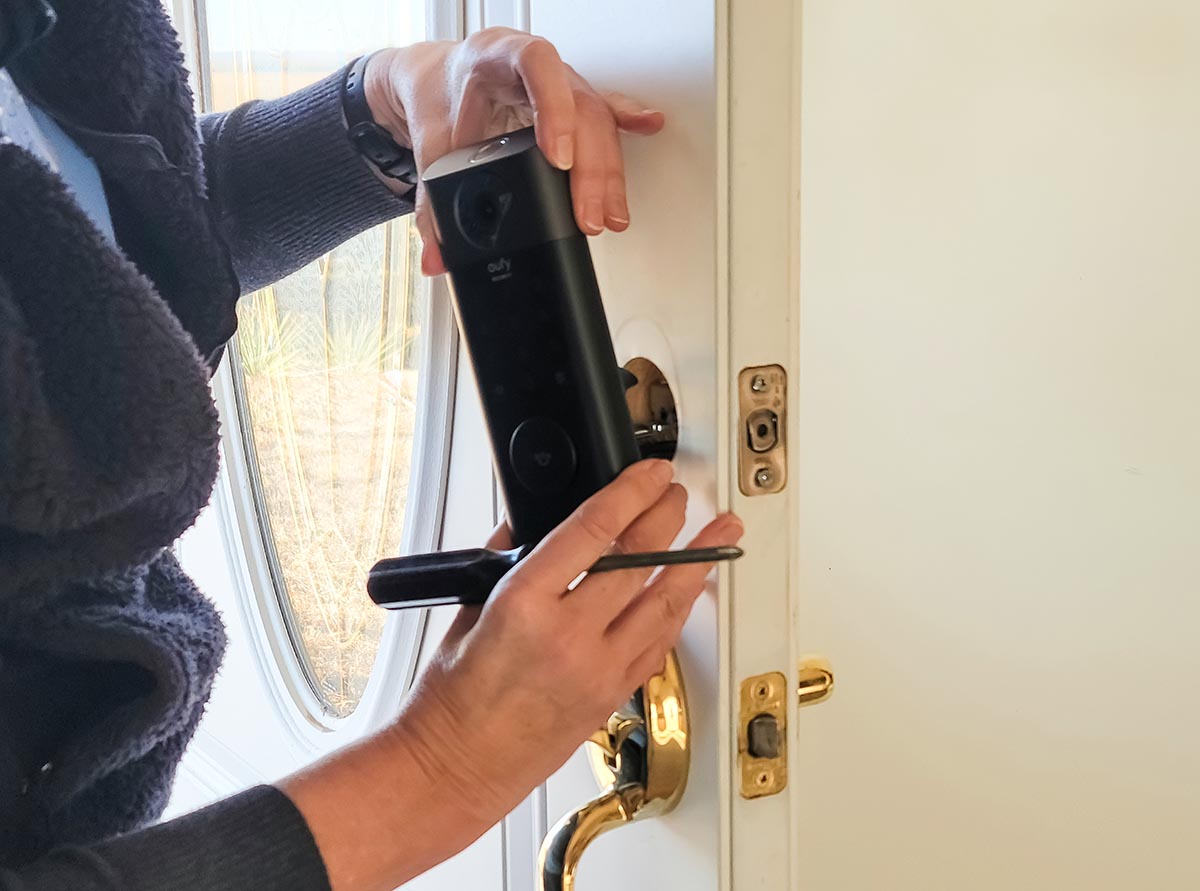
Our Top Picks
To qualify for a spot on our lineup of the best smart locks, the following models had to be straightforward to install (virtually all door locks install in a similar manner and are easy to replace with just a screwdriver). They had to sync with our smart devices via Bluetooth or Wi-Fi easily, and their functions had to be simple to operate. The following smart locks vary in cost and features, but they all earned a spot on our lineup by providing reliable keyless-entry options.
Best Overall
Eufy Smart Lock Touch
See ItPros
- Offers several methods of operation, including fingerprint access, a keypad, voice activation, and a backup key
- Motion detection can be configured to send an alert to a smartphone to notify the user that a visitor is at the door
- The video quality is good; facial features are easy to see
Cons
- A relatively pricey smart door lock
- It may be best to use this lock on a door without a storm door, as our storm door created just enough shadow to trigger the camera’s night vision during the day
Product Specs
- Operations: Touchpad, fingerprint, app, voice activation, key
- Alarm: No
- Connectivity: Wi-Fi, Bluetooth
In the past few years, we’ve tested and installed many Eufy security devices, including security cameras and motion-detection floodlights, so we’re familiar with the brand’s high quality. We already had the Eufy app on our smartphone, so once we installed the door lock and activated it (by installing the batteries), the app detected it immediately. Following the steps on the app, we set a security code and entered our fingerprints into the lock’s memory.
Once everything was configured, we started testing. We used fingerprints and the security code to open the lock from outside—both worked flawlessly. We also used voice control via our Alexa system to open and close the lock remotely. We rang the doorbell, which connects wirelessly to an inside chime module that plugs into an electrical outlet, and we viewed the camera videos from our smartphone. The videos were very clear, although a shadow from our storm door (when closed) kept triggering the camera’s night vision setting by blocking some of the sunlight. That was really the only downside to the Eufy smart lock, which we deem very easy to install, sync, and operate.
Get the Eufy Smart Lock at Amazon, Best Buy, or Newegg.
Best Bang For The Buck
Wyze Smart Lock
See ItPros
- Easy to install—only the interior of an existing deadbolt is replaced
- Uses a Bluetooth receptor (gateway) to sync the lock with a smartphone
- Users can lock and unlock the Wyze remotely via the app
- It will function within 50 feet of the receptor, even if the user does not have a Wi-Fi network
Cons
- Slightly misleading advertising since the Wi-Fi module does not come with the lock and must be ordered separately
Product Specs
- Operations: App (Wi-Fi with module sold separately)
- Alarm: No
- Connectivity: Bluetooth
This budget-friendly smart lock replaces only the interior part of a deadbolt while retaining the existing exterior part of the lock. While this was one of the simplest locks to install, be aware that it’s not an entire replacement deadbolt. The existing center section (the strike) and the exterior part of the deadbolt will remain, so those looking to replace the whole deadbolt should choose a different model.
The unit comes with a Bluetooth receptor (Wyze gateway) that plugs into an indoor outlet (within 50 feet of the lock). We downloaded the Wyze app, which synced with the gateway and walked us through the configuration process. We could lock and unlock the deadbolt from our smartphone, and the gateway sent an alert to our phone when the door opened or closed. The app also records each time the lock is activated.
The Wyze also came with another interesting function: an auto-lock. We could configure the deadbolt to lock itself a few seconds after the door closed. We feel this could be handy for situations where the user is in a hurry and doesn’t want to take the time to lock the door from the app. However, it became slightly annoying when we were going in and out of the house, and the door kept locking each time.
A downside to this model is that the module that makes this lock Wi-Fi capable is sold separately; without it, the lock won’t sync with a home network, so we couldn’t test that aspect. Still, this is an affordable and reliable option for those who want the convenience of opening and closing a lock from a smartphone app without needing a key.
Get the Wyze smart lock at Amazon, Best Buy, or Wyze.
Best with Fob
Smonet Smart Lock With Handle | ZNS-H001
See ItPros
- Handle on the Smonet can be quickly configured to doors that open to the right or the left
- App is comprehensive; the configuration steps are easy to follow and understand
- The 2 included fobs offer another way to open the door, and it comes with backup keys
Cons
- Connecting the lock to a smart-home system requires purchasing a gateway hub
- Handle-type locks don’t offer as much security as deadbolt locks
Product Specs
- Operations: App, keypad, fingerprint, fob, key
- Alarm: No
- Connectivity: Bluetooth, Wi-Fi (requires separate hub)
The Smonet Smart Lock offers keyless access while replacing an existing doorknob for doors that don’t have a separate deadbolt. We replaced a keyed knob on an exterior door in our shop, which allowed us to use the new lock’s keypad and fingerprint sensor to unlock the door rather than feeling around on top of the door jamb for the spare key. It also comes with two fobs (small electronic cards that unlock the door when held against the keypad).
One of the neatest things about this smart lock is that the handle can be quickly switched from one side to the other, so it can be installed on a door that opens from the right or the left. Other handle locks can also be configured to do this, but they often require disassembling the lock to do so. With the Smonet, it was just a matter of depressing a lever and twisting the handle to the other side. Nice!
Once it was installed, we downloaded the app, and it walked us through the configuration process. We’re familiar with several security product apps, and we felt the Smonet app was one of the most self-explanatory. It’s comprehensive, making it well suited for anyone needing extra help configuring a lock. We chose a passcode and entered our fingerprints into the lock’s memory, and the lock opened easily using either.
The included fobs offer even more versatility—all we had to do was hold a fob against the keypad to unlock the door. The fobs can be attached to keychains or even the zipper of a child’s coat. All the features we tested ran on Bluetooth, but they can be connected to Wi-Fi and synced with Alexa or Google Home by purchasing a separate gateway hub to access those features.
Get the Smonet smart lock at Amazon or Smonet.
Best Fingerprint Reader
Ultraloq U-Bolt 6-in-1 Smart Deadbolt
See ItPros
- An attractive alternative to typical square and rectangular keypads
- Bright green light illuminates the unit, letting users see the numbers and fingerprint scan sensor in the dark
- Lock can be configured to unlock automatically when a smartphone with the app installed nears the door
Cons
- Separate purchase of a Wi-Fi hub is necessary to connect to a smart-home system
Product Specs
- Operations: App, keypad, fingerprint scanner (smart-home connectivity with additional hub purchase)
- Alarm: No
- Connectivity: Bluetooth, Wi-Fi (with hub purchase)
The Ultraloq smart lock uses Bluetooth and a downloaded app to unlock and lock the door from a smartphone. It will also sync with a home network via Wi-Fi, but that requires purchasing a separate hub (which we did not have for testing).
The Ultraloq installed easily on an exterior door with an existing deadbolt lock. We were able to download the app by scanning a QR code in the user’s manual, and the app walked us through the configuration process. This smart lock operates like the other models we tested, but we really liked its attractive appearance, which features number keys in a circle around a fingerprint scanner that sits in the center of the keypad. In addition, when the keypad is touched, a bright green light clearly illuminates the buttons, even at night.
Using the app, it was simple to choose a passcode, and we configured the fingerprint scanner to read four different fingerprints. A nice feature is the adjustable auto-lock timer that we set to automatically engage the lock 30 seconds after closing the door. What’s more, this unit features auto unlock, which senses when the smartphone is nearing the door (at about 7 feet) and unlocks it.
It would have been nice to sync the Ultraloq with our smart-home system, but it was sold separately, like some of the other locks we tested. It is advertised to work with Alexa and Google Home, however, if a Wi-Fi hub is installed.
Get the Ultraloq smart lock at Amazon or Lowe’s.
Best with Alarm
Schlage Encode Smart Wi-Fi Deadbolt With Camelot Trim
See ItPros
- The smart lock is simple to install after removing an existing deadbolt
- Wi-Fi capability is built into the lock—no additional hub or purchase is necessary
- Users can control the lock remotely via a smartphone or other device
- Users can set an audible alarm that sounds when the lock is activated
Cons
- The light on the backlit keyboard is dim and could be brighter
Product Specs
- Operations: Keypad, app, voice recognition, key
- Alarm: Yes
- Connectivity: Wi-Fi, Alexa
Schlage is the maker of some of our favorite doorknobs and deadbolts, so we were excited to see how the company’s new smart lock model fared. We were not disappointed. The Schlage lock was simple to install, and we scanned the QR code in the quick-start guide to download the app. We synced the lock with our Wi-Fi network by following the easy steps on the app.
With several configuration options available, we started by setting the audible alarm to sound when the door lock was unlocked. The alarm was loud—but not piercing—and we could hear it from any floor in the house. We then muted the alarm but opted to receive smartphone notifications when the lock was activated. The app walked us through configuring a key code for manual use, and we were also able to add several other key codes the lock responded to, making it well suited for use on an Airbnb or rental property.
Using the app, we connected the Schlage lock with our smart-home system (Alexa), allowing us to use voice control with our Echo Dot to lock and unlock the door. This is an all-around solid-quality lock. It doesn’t offer a camera or other fun bells and whistles, but no additional purchase is needed to use its Wi-Fi capability, and we felt that was worth the slightly higher cost.
Get the Schlage smart lock at The Home Depot, Schlage, or Build.com.
Best Auto Lock
Yale Assure Lock 2 Key-Free Pushbutton Lock Bluetooth
See ItPros
- The backlight on the keypad is bright, so it’s easy to see the keys
- Multiple key codes can be created, making this lock suitable for use with rental homes
- The lock is easy to install; the deadbolt movement is smooth and effortless
Cons
- A separate module must be purchased to use some of the best features on this lock (smart-home integration, voice control, Apple Watch)
Product Specs
- Operations: App, keypad, key, voice activation (requires additional module)
- Alarm: No
- Connectivity: Bluetooth (Wi-Fi and Apple Watch with additional purchase of Yale smart module)
Yale has a long history of making high-quality hardware and locks, and the Assure Lock 2 carries on the company’s tradition. Like most of the smart locks we tested, the Assure is designed to replace an existing deadbolt, and it was straightforward to install, after which we downloaded the Yale app. Though we used an android smartphone to download the Yale app, Apple owners have even more opportunities, including syncing the smart lock with an Apple Watch, which allows users to activate the lock from their watch.
We set the app to recognize multiple keycodes, and we were able to activate the lock remotely from the app. We could configure the auto lock to lock the door anywhere from 30 seconds to 30 minutes after we closed the door. A nice feature that keeps the auto-lock from becoming annoying is a passage button on the inside of the lock that we could press to deactivate the auto-lock function. Of course, we could also turn it off entirely from the app.
The only disappointing aspect was the lack of built-in Wi-Fi. The Assure is compatible with wireless networks, but a Yale smart module is required (sold separately) to connect it.
Get the Yale smart lock at Amazon or Best Buy.
Also Consider
August Smart Lock + Connect Wi-Fi Bridge
See ItPros
- Comes with a Wi-Fi bridge, allowing users to connect it to their wireless network
- Installation is quick and easy, using a single Phillips screwdriver
- August app offers multiple configuration options, including auto lock and auto unlock
Cons
- If the Wi-Fi network goes down, the user will need a key to unlock the lock from the outside
Product Specs
- Operations: App, key (existing keyed deadbolt)
- Alarm: Configurable with some home systems, such as SimpliSafe
- Connectivity: Wi-Fi
Though not much to look at—just an oval-shaped interior deadbolt replacement with a manual thumb knob for locking or unlocking the door from the inside—the August smart lock is designed to work with a deadbolt with an existing keyed outdoor lock. It was a simple process to remove the old deadbolt’s interior section and install the August smart lock. It also includes a bridge module that plugs into a standard outlet and serves as a hub, allowing us to connect the lock with our smart devices via Wi-Fi.
We downloaded the August app, which walked us through multiple configuration options. We were able to set auto lock, which locked the door a few seconds after we left, and we also tried out auto unlock, which unlocked the door when we got about 10 feet away (as long as we had our smartphone with us). We could set multiple key codes and even sync the lock with our Alexa system to use voice controls, such as “Alexa, open the back door.”
The August app offers so many unlocking options that we didn’t feel cheated by its lack of an exterior keypad. Indeed, there is an argument to be made that not seeing a keypad might keep would-be intruders from trying to hack the lock to gain entrance. Plus, those installing the August lock on a door where the exterior keyed deadbolt matches a handset, replacing only the interior section, allows the outside of the door to maintain the same decor style.
Get the August smart lock at Amazon or August.
Jump to Our Top Picks
Types of Smart Locks
There are two types of smart locks: familiar deadbolts upgraded for today’s technology and lever-style locks, typically used for secondary entrances.
Deadbolt
Deadbolts come in various styles, but all are basically a sliding bolt that secures the door to the door jamb. The solid structure of the bolt makes it difficult to force the door open. Many smart deadbolts allow users to set temporary codes to allow entry to guests, unlock a door via fingerprint recognition, integrate with virtual assistants such as Amazon’s Alexa to be voice operated, or use a smartphone connected to Bluetooth or Wi-Fi to control the lock. Anyone who’s ever stood in the rain with an armload of groceries while fumbling for a key can understand the convenience of a keyless entry.
Lever-Style
Lever-style smart locks are a good choice to provide keyless entry for side doors or to lock interior doors, such as those that lead to a garage or guest house. Lever locks are not as secure as deadbolts, so many people don’t put them on a front or main door. Lever-style smart locks may have fingerprint readers, codes, or voice controls through virtual assistants such as Apple’s Siri. Some are also compatible with other smart-home offerings, including security systems.
What to Consider When Choosing the Best Smart Lock
When choosing a smart lock, primary considerations include the door to be secured, who will be entering, and how often they will be entering. If choosing a lock for an Airbnb rental, shoppers may want a smart lock that lets them recode entry passwords. If they want added security for a front door, the best smart lock might be one with an alarm. Consider some of the following smart-lock fundamentals to help make the right choice.
Battery Life
Most smart locks use four AA batteries, which generally last 6 months to a year depending on the lock model and how often the lock is opened or closed. To help extend the life of batteries, correctly install the lock and make sure the door is properly aligned. Door-alignment problems can drain the batteries because they keep the locking bolt from sliding easily, requiring the batteries to work harder to engage and disengage the bolt.
Touch Screen
The touch screen of a smart lock can offer a variety of options, including fingerprint recognition and more than 50 customized user codes, so users can lock and unlock the door with a touch or a code. Some locks rotate the code numbers on the touch screen for extra security. Others have up to 100 virtual keys that can be managed remotely through a smartphone app.
Wireless Security and Connectivity
Wireless security with a smart lock can be a double-edged sword. If the power goes out, the app gets a glitch, the Wi-Fi fails, or the batteries in the user’s phone or smart lock go dead, they may not be able to get into their own home. Owners will want to carry a traditional house key as a backup. Virtually all smart locks come with backup keys for use in an emergency.
Keep smart-lock software updated and powered with fresh batteries to ensure safety and functionality. Other best practices with a smart lock include using a 16- to 20-character password, ensuring the lock uses encryption to shield it from hackers, and enabling two-factor authentication (such as a code plus a fingerprint).
Smart-Home Compatibility
There are great smart locks and there are great smart-home systems, but the two products may not jibe. This can be true even if both the lock and home systems are controlled by the same digital assistant. If shoppers want a smart lock that connects to a smart-home system, the best bet is to ensure the two are designed to work together. For example, if already using a smart-home system such as Google Assistant, Alexa, or Wink, look for a smart lock that is compatible with the existing system.
Voice Control
Each year, more smart locks feature voice control via Apple’s Siri, Amazon’s Alexa, and Google’s Assistant. Smart locks can be controlled with these voice assistants much the same way as other devices are managed. Many people use commands such as “Hey, Siri, unlock the front door.” That’s convenient, but it can also be unsafe. Security experts have shown it’s relatively easy for anyone to use an audio transducer—a device that can turn whatever surface it’s on, such as a window, into a speaker—to command a voice assistant to unlock a door. If choosing to use voice control, it’s best to use a personal identification number or another form of verification to keep the home safe.
Waterproofing
All smart locks are water-resistant and have some form of waterproofing to protect the front from rain, snow, and the occasional stream from a garden hose. The lock’s back is not waterproof, though, so it may fail if it is submerged, such as during a flood. Fully waterproofing a smart lock is expensive and not a common practice.
Additional Features
Smart locks have features designed for various lifestyles. Some allow unlocking the door with a fingerprint. Others let users program access codes quickly, which is helpful if they wish to give out-of-town guests access to their property for a specific time. There are even smart locks for interior rooms that only the room occupant can control—ideal for people who have roommates but want added privacy. Some even send a message to a smartphone if a door was left open or the doorbell rings.
Style and Finish
Some smart locks have the same style and finish options as traditional locks, while others come in just black or silver. Most smart locks are slim and sleek, and many have a keypad for entering a password. The downside to keypads is they tell the world the lock is smart, which might entice tech-savvy hackers to tamper with it. The latest look in smart locks mimics the appearance of a traditional deadbolt. Users can still gain entrance with a fingerprint, voice command, or a programmable keycard, but the style disguises the lock’s digital capabilities.
The Advantages of Owning a Smart Lock
The main advantage of a smart lock is keyless entry into a home. Smart locks also allow owners to monitor entry into and activity around the door, assign codes for limited access, integrate with virtual assistants and smart-home systems, and lock or unlock their door remotely. Other features include:
- Secure keyless entry through a unique passcode, fingerprint, or voice command
- Added security through an alarm or remote visual monitoring
- Easy installation
FAQs
A smart lock works much like a traditional lock but is controlled by voice, fingerprint, passcode, or remote connectivity via a smartphone.
Keypads, touch screens, and traditional locks are among the possible smart-lock door components.
That varies by manufacturer and model. Locks come with instructions, but generally, you program a number into the lock, push the buttons as instructed by the manufacturer, and it’s all set.
Yes, smart door locks can be hacked (or picked), but proper installation lessens the danger.
